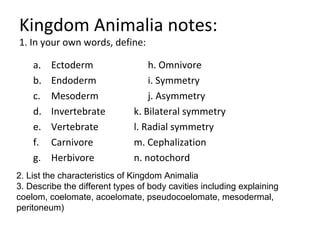
kingdom animalia & phylum porifera
- 1. Kingdom Animalia notes: 1. In your own words, define: a. Ectoderm b. Endoderm c. Mesoderm d. Invertebrate e. Vertebrate f. Carnivore g. Herbivore h. Omnivore i. Symmetry j. Asymmetry k. Bilateral symmetry l. Radial symmetry m. Cephalization n. notochord 2. List the characteristics of Kingdom Animalia 3. Describe the different types of body cavities including explaining coelom, coelomate, acoelomate, pseudocoelomate, mesodermal, peritoneum)
- 2. ANSWERS: a. Ectoderm – the layer of the gastrula that will form the outer part of the body b. Endoderm – the layer of the gastrula that will form the inside of the body c. Mesoderm – the layer of the gastrula that will form muscles, reproductive organs, kidneys, blood vessels and bone.
- 5. ANSWERS: d. Invertebrate – animal with no backbone e. Vertebrate – animals with notochord (at some stage of their life) f. Carnivore – animals that eat other animals g. Herbivore – animals that only eat plants h. Omnivore – animals that eat both plant and animals i. Symmetry – refers to the pattern of body plans in animals and is the balanced distribution of duplicate body parts j. Asymmetry – lacking balanced distribution
- 6. k. Bilateral symmetry – right & left halves are mirror images l. Radial symmetry – symmetry around a central axis m. Cephalization – concentration of nerve tissue at the anterior end of the animal’s body (e.g. brain) n. Notochord – flexible rod-shaped body that runs lengthwise along the dorsal surface beneath the nerve cord (turns into vertebrae column in most vertebrates)
- 7. 3 types of symmetry: Asymmetrical Radial Bilateral EVOLUTION 7
- 8. Symmetry
- 9. 9
- 10. Kingdom Animalia
- 11. Kingdom Animalia Characteristics: – Eukaryotic – All multicellular – All heterotrophic – Motile (moveable) – Most reproduce sexually, some asexually or both
- 12. Classification of Animals • Organisms are grouped into taxa on the basis of similar characteristics • Evolutionary patterns are evident as animals developed more complexity • Characteristics for classification: 1. Tissue organization 2. Symmetry 3. Gastrulation 4. Body Cavities
- 13. 1. Tissue Organization • Tissue: Group of similar cells from the same developmental origin that work together to carry out a specific function. • Tissues group and function together to form organs. • Organs working together are called a system
- 14. 2. Symmetry • Organisms may exhibit asymmetry, radial symmetry or bilateral symmetry. • More complex organisms tend to be bilaterally symmetrical
- 15. 3. Gastrulation • A developing zygote forms a hollow ball of cells. • The ball of cells folds inward forming an opening and inner cavity • The opening will develop and form either: – Mouth (Protostome) – Anus (Deuterostome)
- 17. 4. Body Cavities • Body Cavity: Fluid filled space between the outer covering (ectoderm) and lining of the gut cavity (endoderm) • Acoelomate: Organisms with no fluid filled body cavity • Pseudocoelomate: Fluid filled cavity partially lined by mesoderm • Coelomate: Cavity fully lined by mesoderm
- 18. Body Cavities
- 21. Animal Phyla we will study: Porifera • Sponges • 10,000 known species • Calcareous, glass, coralline (tropical), demosponges (like the bath sponge) 21
- 22. Cnidaria • Sea anemone • Coral • Jellyfish • Hydra 22
- 23. Platyhelminthes • Planarians • Flukes • Tapeworms 23
- 25. Annelida • Oligochaeta: Earthworms • Hirudinea: Leeches • Polychaeta: 25
- 26. Mollusca • Bivalves: clams, oysters, mussels • Gastropods: Snails, nudibranchs • Chitons • Cephalopods: Squid, Octopus 26
- 27. Echinodermata • Sea urchin • Sand dollar • Sea star • Sea cucumber 27
- 28. Arthropoda • Spiders • Crustaceans (crab, lobster) • Insects 28
- 29. Chordata (Vertebrates) • Animals with a backbone 29
- 31. Brain Sponge
- 32. Cloud Sponge
- 34. Sponges – Simplest Animals • Sponge embryos does not have any layers, just cells. • No specialized tissues or organs • Many similarities to colonial single celled organisms • Classified in Kingdom Animalia because they are eukaryotic, multicellular, and heterotrophic
- 36. Characteristics: • Body type: asymmetrical • Ecological roles: – food source – homes/shelter – symbiotic with bacteria • Body organization : – Diploblastic – 2 germ layers: endoderm and ectoderm. • Body cavity: acoelomate
- 37. Characteristics continued: • Digestive system: – Filter feeders – using ostia, collar cells, food vacuoles & osculum
- 38. • Reproduction: – Sexual: hermaphroditic • Sponges undergo metamorphosis from free swimming larvae to sessile adult – Asexual: budding, branching, & fragmentation Characteristics continued:
- 41. Characteristics continued: • Circulation: diffusion • Nervous system: none • Respiration & excretion: diffusion • Habitat: aquatic – oceans and lakes
- 42. Additional Characteristics: • Sessile – cannot move (larva is motile) • Able to regenerate = can regrow missing or damaged body parts. • Simplest and most primitive animals • Has spicules – glass-like structures that give support and structure
- 44. The Wonderful World of Sponges (start at 1 minute): http://www.youtube.com/watch?v=BW05vMziy2o&NR=1&feature=fv You tube sponge reproduction: http://www.youtube.com/watch?v=BW05vMziy2o